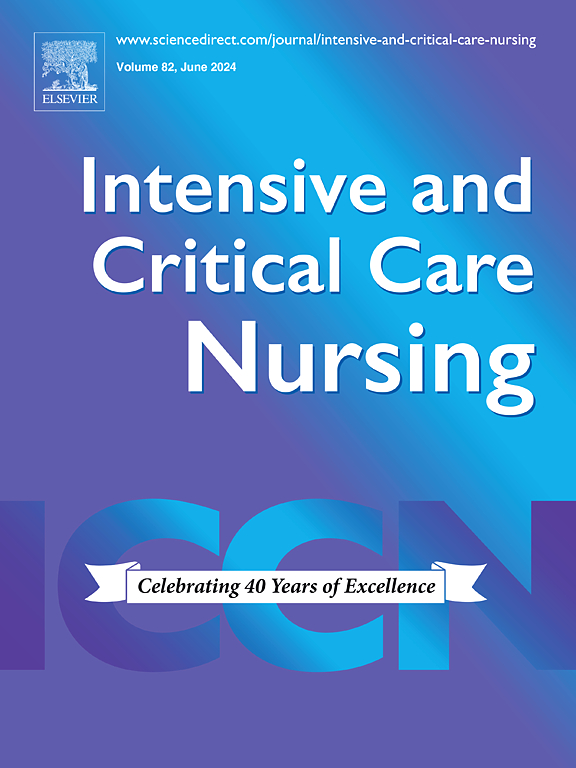去甲肾上腺素与 COVID-19 相关急性呼吸窘迫综合征重症患者压疮发生的关系:剂量反应分析
IF 4.9
2区 医学
Q1 NURSING
引用次数: 0
摘要
目的研究重症监护病房(ICU)中不同剂量去甲肾上腺素(NE)与 COVID-19 患者压力损伤(PIs)发生率之间的相关性:一项回顾性多中心研究针对 1078 名因急性呼吸窘迫综合征(ARDS)需要机械通气而入住重症监护病房的 COVID-19 患者。研究时间跨度为 2020 年 3 月至 2021 年 4 月,涉及伊朗五所大学附属医院。研究利用单变量和多变量二元逻辑回归分析以及线性和非线性剂量反应评估来评估 NE 剂量与 PI 发生概率之间的关系:多变量分析表明,24 小时内较高剂量的 NE(OR:1.832,95 % CI:1.218-2.754,P=0.004)和累积剂量(OR:1.408,95 % CI:1.204-1.975,P=0.048)与 PI 的发生有显著关系。此外,与低剂量或中等剂量的患者相比(>15 µg/min vs. ≤ 15 µg/min;OR:4.401,95 % CI:3.339-5.801,P=0.001),接受高剂量 NE 的患者发生 PIs 的风险增加了近四倍(无论 PIs 分期如何)。虽然线性剂量-反应分析未显示 NE 剂量(µg/min)与 PI 发生之间存在显著相关性(P>0.05),但非线性分析表明 NE 剂量≤ 9 µg/min 与 PI 发生风险降低有关:结论:将 NE 输注维持在 1-9 µg/min 的范围内似乎能最有效地降低 COVID-19 ICU 患者发生 PI 的可能性。较低的NE剂量(≤9 µg/min)与较低的PI发生风险相关,这表明在该患者群中,NE剂量以外的因素或使用其他血管加压剂可能对PI的形成起着至关重要的作用:临床实践的启示:临床医生不应提出特定的阈值,而应考虑开展进一步研究,以确定平衡微血管灌注和患者预后的最佳剂量。全面评估其他因素并有选择性地使用血管加压药至关重要。个体化治疗,包括定期监测和个性化治疗方案,对于这类患者获得最佳治疗效果至关重要。本文章由计算机程序翻译,如有差异,请以英文原文为准。

Association of norepinephrine with pressure ulcer development in critically ill patients with COVID-19-related acute respiratory distress syndrome: A dose–response analysis
Objectives
To investigate the correlation between varying doses of norepinephrine (NE) and the incidence of pressure injuries (PIs) in COVID-19 patients in intensive care units (ICUs).
Design
A retrospective multicenter study was conducted on 1,078 COVID-19 patients admitted to ICUs with acute respiratory distress syndrome (ARDS) requiring mechanical ventilation. The research spanned from March 2020 to April 2021 across five university-affiliated hospitals in Iran. Univariate and multivariate binary logistic regression analyses, along with linear and non-linear dose–response assessments, were utilized to evaluate the relationship between NE dosages and the probability of PI development.
Findings
The multivariate analysis revealed a significant association between higher doses of NE administered over 24 h (OR: 1.832, 95 % CI: 1.218–2.754, P=0.004) and cumulative doses (OR: 1.408, 95 % CI: 1.204–1.975, P=0.048) with the occurrence of PIs. Moreover, patients receiving high NE doses had a nearly fourfold increased risk of developing PIs, regardless of PIs stage, compared to those on low or moderate doses (>15 µg/min vs. ≤ 15 µg/min; OR: 4.401, 95 % CI: 3.339–5.801, P=0.001). Although the linear dose–response analysis did not show a significant correlation between NE doses and PI development (P>0.05), the non-linear analysis indicated that NE doses ≤ 9 µg/min were associated with a reduced risk of PI development.
Conclusion
Maintaining NE infusion within the range of 1–9 µg/min appears to be most effective in reducing the likelihood of PIs in ICU patients with COVID-19. Lower NE doses (≤9 µg/min) were associated with a lower risk of PI development, suggesting that factors beyond NE dosage or the use of other vasopressors may play a crucial role in PI formation in this patient cohort.
Implications for Clinical Practice
Rather than suggesting a specific threshold, clinicians should consider further studies to determine the optimal dose that balances microvascular perfusion and patient outcomes. It is crucial to comprehensively evaluate additional factors and selectively use vasopressors. Individualized care, including regular monitoring and personalized treatment plans, is essential for achieving the best outcomes in this patient population.
求助全文
通过发布文献求助,成功后即可免费获取论文全文。
去求助
来源期刊

Intensive and Critical Care Nursing
NURSING-
CiteScore
6.30
自引率
15.10%
发文量
144
审稿时长
57 days
期刊介绍:
The aims of Intensive and Critical Care Nursing are to promote excellence of care of critically ill patients by specialist nurses and their professional colleagues; to provide an international and interdisciplinary forum for the publication, dissemination and exchange of research findings, experience and ideas; to develop and enhance the knowledge, skills, attitudes and creative thinking essential to good critical care nursing practice. The journal publishes reviews, updates and feature articles in addition to original papers and significant preliminary communications. Articles may deal with any part of practice including relevant clinical, research, educational, psychological and technological aspects.
 求助内容:
求助内容: 应助结果提醒方式:
应助结果提醒方式:


